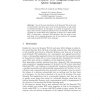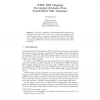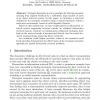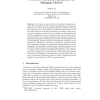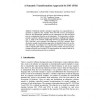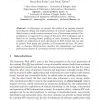ER
2006
Springer
14 years 4 months ago
2006
Springer
One of the main drawbacks of the Semantic Web is the lack of semantically rich data, since most of the information is still stored in relational databases. In this paper, we presen...
ER
2006
Springer
14 years 4 months ago
2006
Springer
When trying to obtain semantical interoperability between different information systems, the integration of heterogeneous information sources is a fundamental task. An important st...
ER
2006
Springer
14 years 4 months ago
2006
Springer
The UML 2 Activity Diagram is designed for modelling business processes, but does not yet include any concepts for modelling process goals and their measures. We extend the UML 2 A...
ER
2006
Springer
14 years 4 months ago
2006
Springer
The W3C is working on a Recommendation for Web Services Description Language, WSDL 2.0, based on XML. The Working Group is chartered to produce a normative mapping of WSDL into RDF...
ER
2006
Springer
14 years 4 months ago
2006
Springer
Abstract. The United Nation's Centre for Trade Facilitation and Electronic Business (UN/CEFACT) is an e-business standardization body. It is known from its work on UN/EDIFACT ...
ER
2006
Springer
14 years 4 months ago
2006
Springer
Emergent Semantics is a new paradigm for inferring semantic meaning from implicit feedback by a sufficiently large number of users of an object retrieval system. In this paper, we ...
ER
2006
Springer
14 years 4 months ago
2006
Springer
Abstract. The notion of user preference in database modeling has recently received much attention in advanced applications, such as personalization of e-services, since it captures...
ER
2006
Springer
14 years 4 months ago
2006
Springer
Abstract. Traditional industries anticipate supporting cross-organizational cooperation as applied in the semantic Web and Web services environments. However, the international sta...
ER
2006
Springer
14 years 4 months ago
2006
Springer
regated Graphs for Modeling Spatio-Temporal Networks - An Extended Abstract Technical Report Department of Computer Science and Engineering University of Minnesota 4-192 EECS Build...
ER
2006
Springer
14 years 4 months ago
2006
Springer
In this paper, we present the results of an ongoing research involving the design and implementation of systems supporting personalized access to multi-version resources in an eGov...
